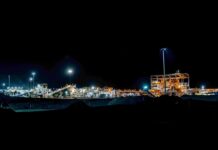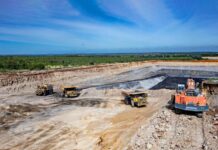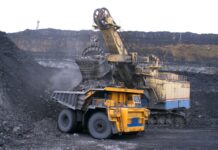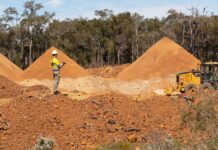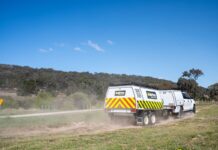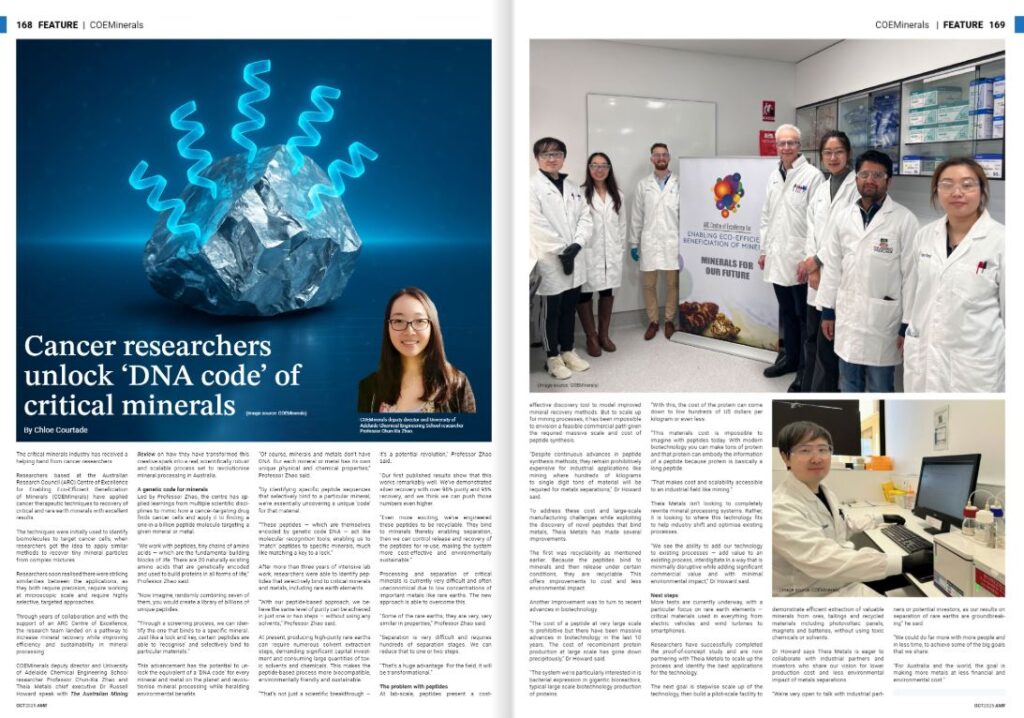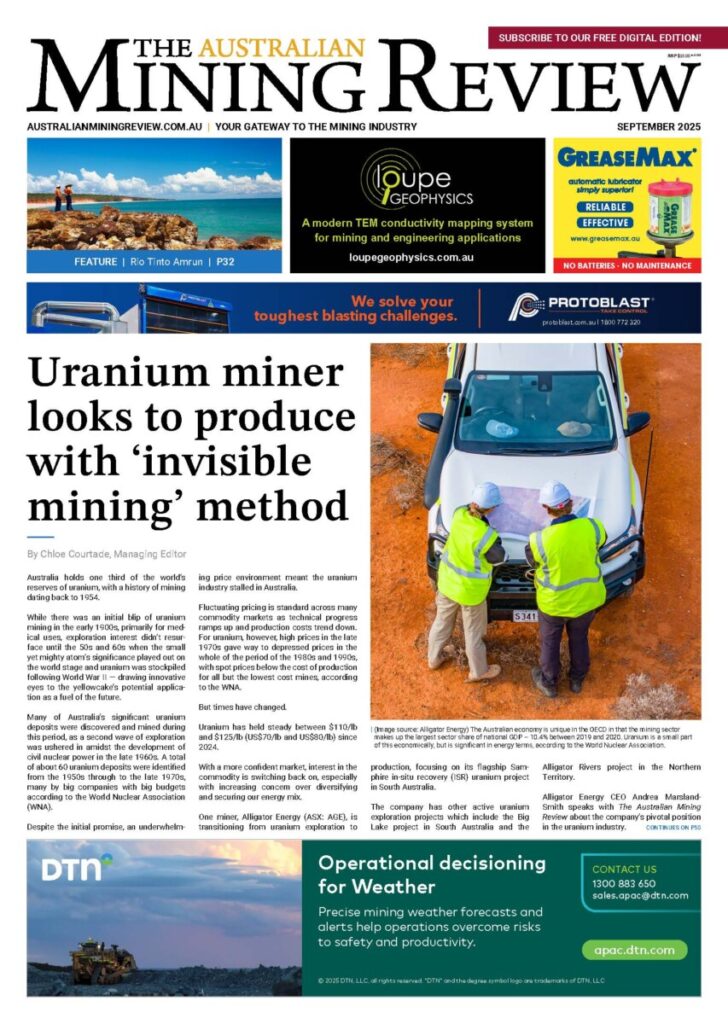Cancer researchers unlock ‘DNA code’ of critical minerals
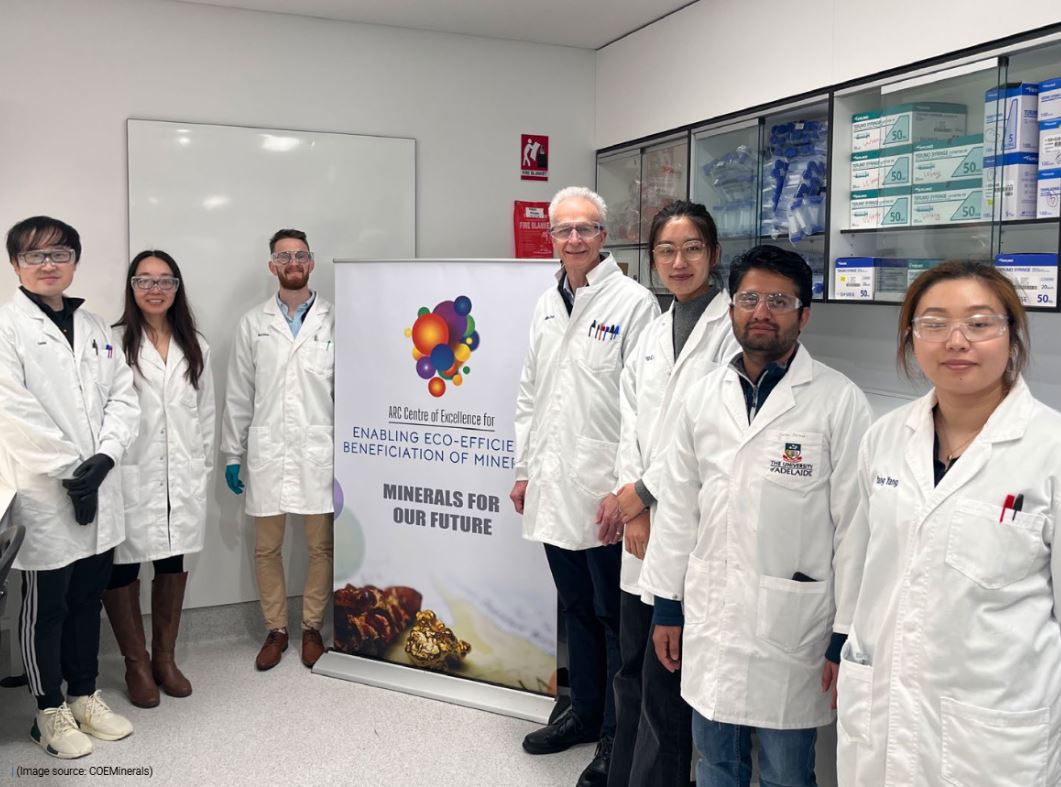
The critical minerals industry has received a helping hand from cancer researchers.
Researchers based at the Australian Research Council (ARC) Centre of Excellence for Enabling Eco-Efficient Beneficiation of Minerals (COEMinerals) have applied cancer therapeutic techniques to recovery of critical and rare earth minerals with excellent results.
The techniques were initially used to identify biomolecules to target cancer cells, when researchers got the idea to apply similar methods to recover tiny mineral particles from complex mixtures.
Researchers soon realised there were striking similarities between the applications, as they both require precision, require working at microscopic scale and require highly selective, targeted approaches.
Through years of collaboration and with the support of an ARC Centre of Excellence, the research team landed on a pathway to increase mineral recovery while improving efficiency and sustainability in mineral processing.
COEMinerals deputy director and University of Adelaide Chemical Engineering School researcher Professor Chun-Xia Zhao and Theia Metals chief executive Dr Russell Howard speak with The Australian Mining Review on how they have transformed this creative spark into a real, scientifically robust and scalable process set to revolutionise mineral processing in Australia.
A genetic code for minerals
Led by Professor Zhao, the centre has applied learnings from multiple scientific disciplines to mimic how a cancer-targeting drug finds cancer cells and apply it to finding a one-in-a-billion peptide molecule targeting a given mineral or metal.
“We work with peptides, tiny chains of amino acids — which are the fundamental building blocks of life. There are 20 naturally existing amino acids that are genetically encoded and used to build proteins in all forms of life,” Professor Zhao said.
“Now imagine, randomly combining seven of them, you would create a library of billions of unique peptides.
“Through a screening process, we can identify the one that binds to a specific mineral. Just like a lock and key, certain peptides are able to ‘recognise’ and selectively bind to particular materials.”
This advancement has the potential to unlock the equivalent of a ‘DNA code’ for every mineral and metal on the planet and revolutionise mineral processing while heralding environmental benefits.
“Of course, minerals and metals don’t have DNA. But each mineral or metal has its own unique physical and chemical properties,” Professor Zhao said.
“By identifying specific peptide sequences that selectively bind to a particular mineral, we’re essentially uncovering a unique ‘code’ for that material.
“These peptides — which are themselves encoded by genetic code DNA — act like molecular recognition tools, enabling us to ‘match’ peptides to specific minerals, much like matching a key to a lock.”
After more than three years of intensive lab work, researchers were able to identify peptides that selectively bind to critical minerals and metals, including rare earth elements.
“With our peptide-based approach, we believe the same level of purity can be achieved in just one or two steps — without using any solvents,” Professor Zhao said.
At present, producing high-purity rare earths can require numerous solvent extraction steps, demanding significant capital investment and consuming large quantities of toxic solvents and chemicals. This makes the peptide-based process more biocompatible, environmentally friendly and sustainable.
“That’s not just a scientific breakthrough — it’s a potential revolution,” Professor Zhao said.
“Our first published results show that this works remarkably well. We’ve demonstrated silver recovery with over 98% purity and 95% recovery, and we think we can push those numbers even higher.
“Even more exciting, we’ve engineered these peptides to be recyclable. They bind to minerals thereby enabling separation, then we can control release and recovery of the peptides for re-use, making the system more cost-effective and environmentally sustainable.”
Processing and separation of critical minerals is currently very difficult and often uneconomical due to low concentrations of important metals like rare earths. The new approach is able to overcome this.
“Some of the rare earths, they are very, very similar in properties,” Professor Zhao said.
“Separation is very difficult and requires hundreds of separation stages. We can reduce that to one or two steps.
“That’s a huge advantage. For the field, it will be transformational.”
The problem with peptides
At lab-scale, peptides present a cost-effective discovery tool to model improved mineral recovery methods. But to scale up for mining processes, it has been impossible to envision a feasible commercial path given the required massive scale and cost of peptide synthesis
“Despite continuous advances in peptide synthesis methods, they remain prohibitively expensive for industrial applications like mining where hundreds of kilograms to single digit tons of material will be required for metals separations,” Dr Howard said.
To address these cost and large-scale manufacturing challenges while exploiting the discovery of novel peptides that bind metals, Theia Metals has made several improvements.
The first was recyclability as mentioned earlier. Because the peptides bind to minerals and then release under certain conditions, they are recyclable. This offers improvements to cost and less environmental impact.
Another improvement was to turn to recent advances in biotechnology.
“The cost of a peptide at very large scale is prohibitive but there have been massive advances in biotechnology in the last 10 years. The cost of recombinant protein production at large scale has gone down precipitously,” Dr Howard said.
“The system we’re particularly interested in is bacterial expression in gigantic bioreactors, typical large scale biotechnology production of proteins.
“With this, the cost of the protein can come down to low hundreds of US dollars per kilogram or even less.
“This materials cost is impossible to imagine with peptides today. With modern biotechnology you can make tons of protein and that protein can embody the information of a peptide because protein is basically a long peptide.
“That makes cost and scalability accessible to an industrial field like mining.”
Theia Metals isn’t looking to completely rewrite mineral processing systems. Rather, it is looking to where this technology fits to help industry shift and optimise existing processes.
“We see the ability to add our technology to existing processes — add value to an existing process, interdigitate in a way that is minimally disruptive while adding significant commercial value and with minimal environmental impact,” Dr Howard said.
Next steps
More tests are currently underway, with a particular focus on rare earth elements —critical materials used in everything from electric vehicles and wind turbines to smartphones.
Researchers have successfully completed the proof-of-concept study and are now partnering with Theia Metals to scale up the process and identify the best applications for the technology.
The next goal is stepwise scale up of the technology, then build a pilot-scale facility to demonstrate efficient extraction of valuable minerals from ores, tailings and recycled materials including photovoltaic panels, magnets and batteries, without using toxic chemicals or solvents.
Dr Howard says Theia Metals is eager to collaborate with industrial partners and investors who share our vision for lower production cost and less environmental impact of metals separations.
“We’re very open to talk with industrial partners or potential investors, as our results on separation of rare earths are groundbreaking” he said.
“We could do far more with more people and in less time, to achieve some of the big goals that we share.
“For Australia and the world, the goal is making more metals at less financial and environmental cost.”






